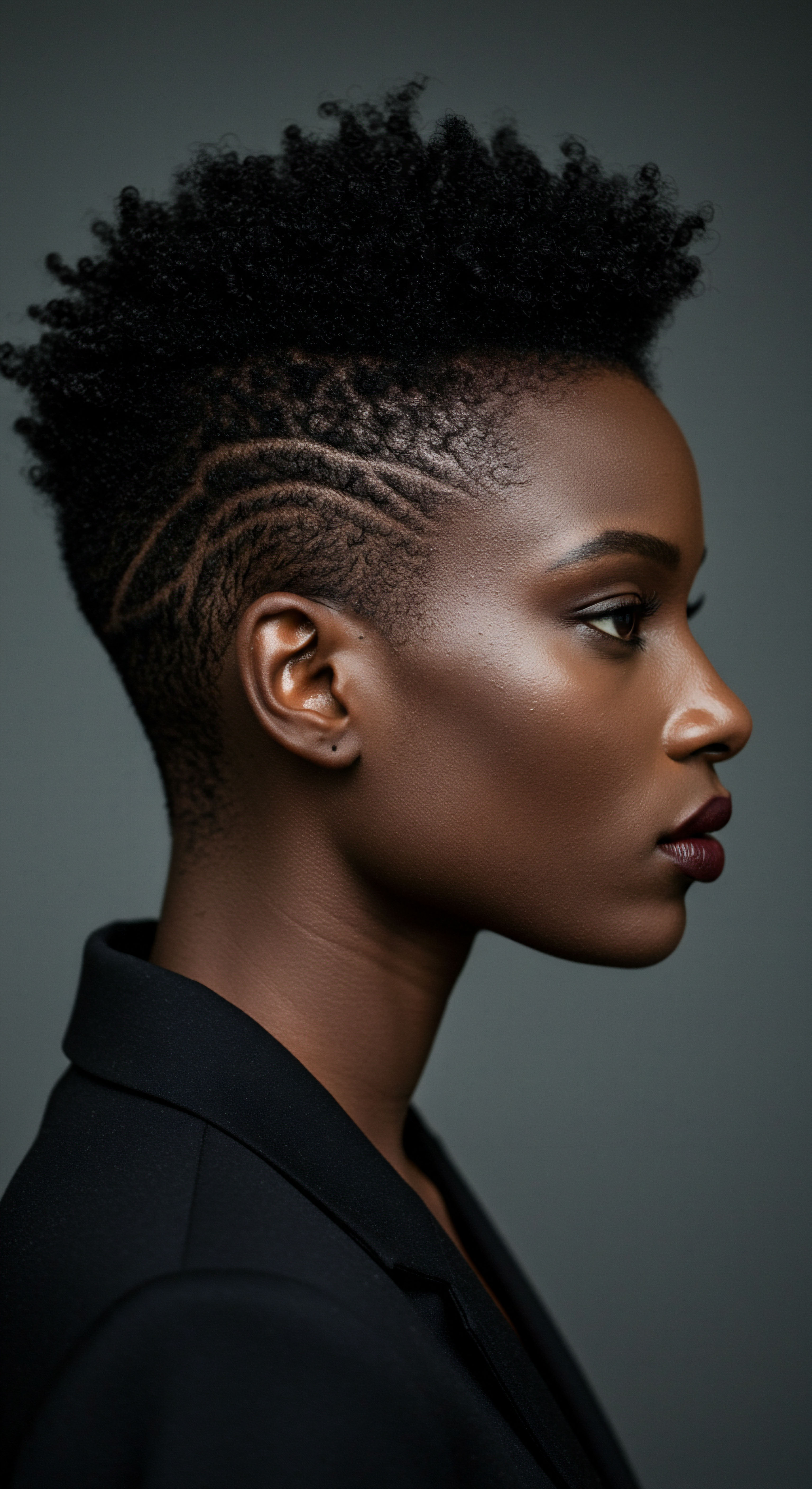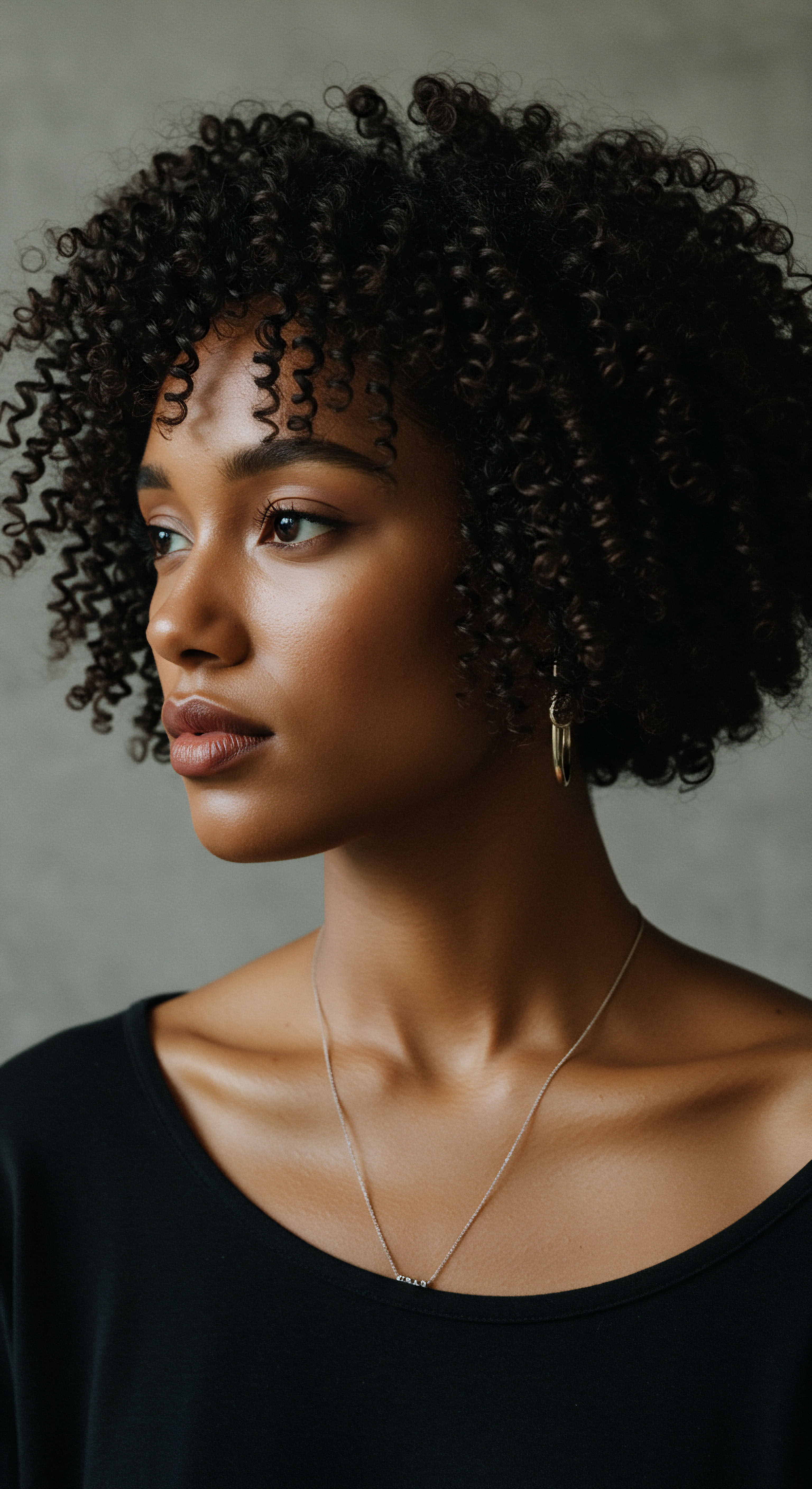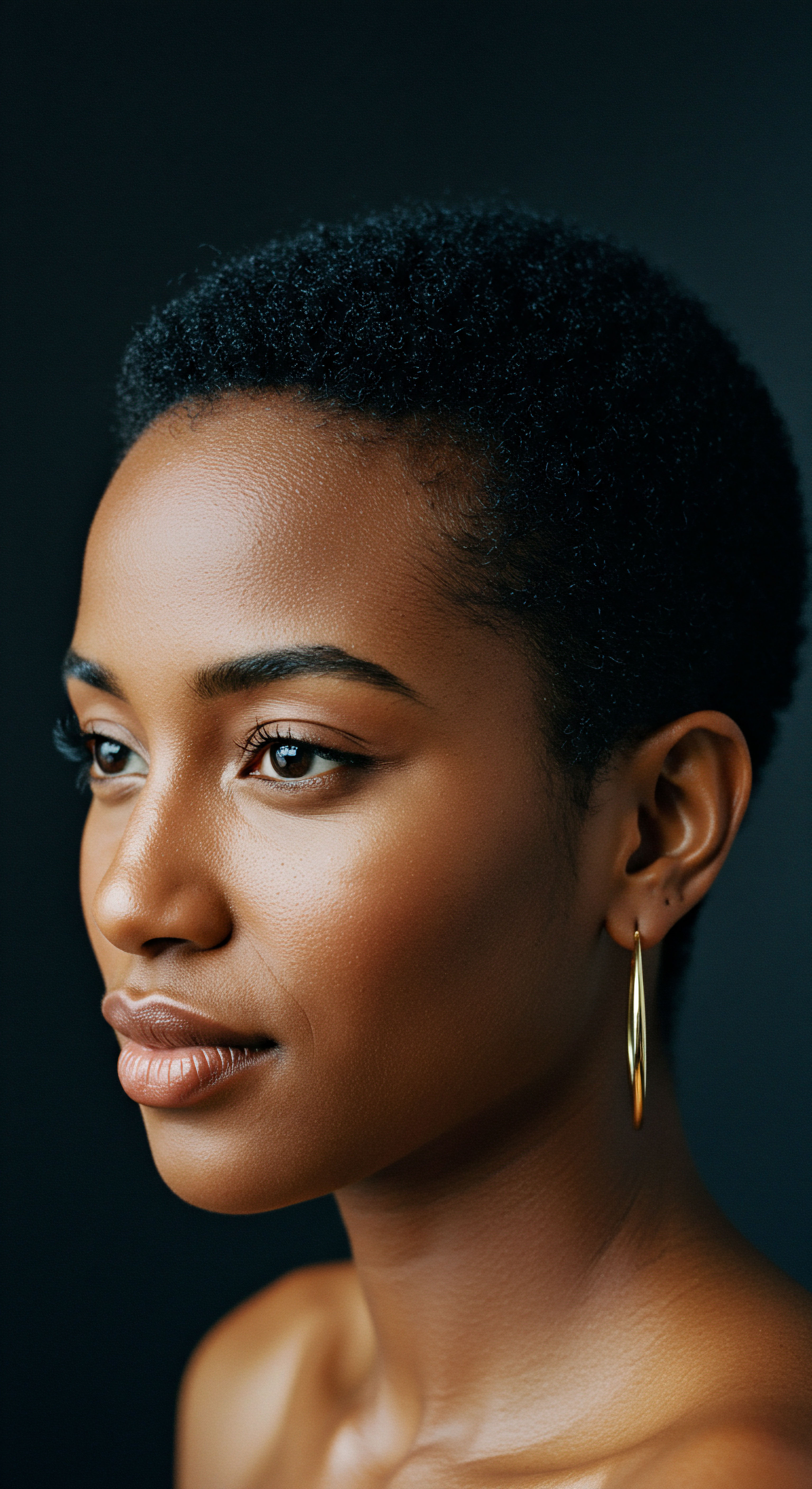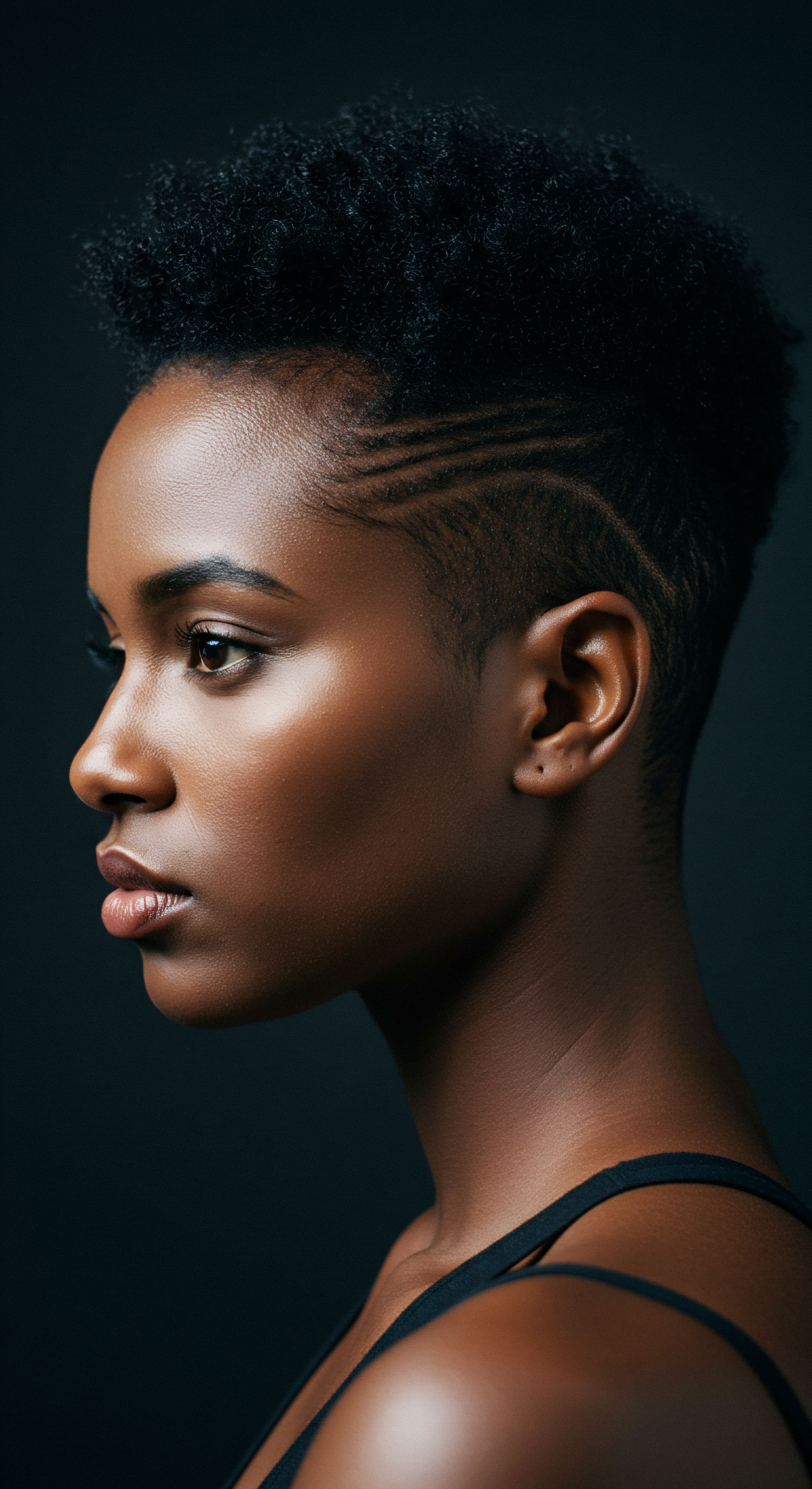
Roots
The quiet moments before slumber, when the day’s concerns begin to soften and the world outside recedes, have long held a special significance across human cultures. Within this gentle transition, the care of hair often found its place, not merely as a practical step for hygiene or appearance, but as a deeply embedded practice reflecting communal values, spiritual beliefs, and an innate understanding of the body’s delicate balance. To consider historical traditions of hair protection during sleep invites us into a lineage of quiet wisdom, where the nightly ritual became a tender act of preservation, safeguarding not only physical strands but also the energetic and symbolic connections hair held within diverse societies. It is a subtle yet powerful narrative, one that speaks to the intimate relationship between humanity and its crowning glory, particularly for those with textured hair, where vulnerability to damage is often heightened.

Ancient Echoes of Hair Protection
From the earliest known civilizations, the protection of hair extended beyond daytime adornment. Ancient Egyptians, for instance, held hair in high regard, often styling it in intricate ways for both daily life and ceremonial occasions. Their understanding of hair care was sophisticated, incorporating oils and specialized preparations. At night, head coverings served to preserve these elaborate styles and to shield the hair from dust and environmental elements.
The use of wigs, a common practice for both aesthetic and hygienic reasons, also necessitated nightly care to maintain their structure and cleanliness. Such practices underscore an early recognition of hair’s fragility and the need for sustained care.
Across the Mediterranean, similar protective impulses manifested. In ancient Greece and Rome, where hair was often styled with considerable effort, coverings or simple bindings at night would have been commonplace to maintain coiffures and prevent tangling. The smooth texture of certain fabrics, perhaps an early precursor to silk, would have been intuitively favored for their gentleness against the hair shaft. These foundational traditions were not always explicitly documented as “sleep rituals” in the same way we might conceive them today, yet their presence can be inferred from the dedication to hair artistry and preservation evident in archaeological findings and historical accounts.
Ancient civilizations recognized the need to protect hair during sleep, often through coverings or careful styling, reflecting its aesthetic and practical importance.

The Sacred and the Strands
Beyond practical concerns, hair held immense spiritual and social weight in many ancient cultures. It was often considered a conduit for energy, a symbol of strength, or a marker of identity. The idea of hair as a repository of personal power meant that its care, particularly during vulnerable states like sleep, carried spiritual implications.
For example, in some African traditions, head coverings were not just about physical protection but also about safeguarding one’s spiritual essence, especially when asleep. The head, being the seat of the spirit, required careful attention.
The significance of hair in various cultures is well-documented. Anthropological studies reveal that hair, when separated from the body, was frequently perceived as a potent item, often linked to ritual behavior and rites of passage. This perception would naturally extend to how hair was treated during sleep, a time when the body is in a state of repose and potentially more susceptible to external influences, both seen and unseen. The act of covering or binding hair at night could thus serve as a protective barrier, a ritualistic seal against unwanted intrusions or energetic disturbances.
- Egyptian Headwear ❉ Early forms of coverings to preserve elaborate wigs and natural hair, protecting from dust and maintaining intricate styles.
- African Spiritual Coverings ❉ Head wraps and cloths used not only for physical protection but also to safeguard spiritual energy during rest.
- Indigenous Bindings ❉ Simple braids or wrapped styles to prevent tangling and preserve hair’s natural integrity, often tied to a respect for nature.

Ritual
As the sun dips below the horizon and the world prepares for its nightly hush, the care of hair transforms from a daily routine into a quiet, often profound, ritual. This transition speaks to a deeper understanding of hair’s vulnerability and the enduring human desire to preserve its health and beauty. The practices we observe today, such as donning a silk bonnet or wrapping strands in a satin scarf, are not modern inventions but rather echoes of long-standing traditions passed down through generations. These nightly customs are a testament to shared wisdom, a practical artistry honed over centuries to shield hair from the rigors of friction and environmental exposure during sleep.

The Global Tapestry of Nighttime Hair Protection
Across continents and eras, diverse cultures developed specific rituals for nighttime hair protection. These practices, while varied in form, shared a common underlying purpose ❉ to preserve hair’s integrity, maintain its moisture, and safeguard intricate daytime styles. From the elegant bindings of Japanese geishas to the practical head wraps of African and Afro-Caribbean communities, the commitment to nightly hair care runs deep.
In ancient Japan, for instance, the elaborate hairstyles worn by geishas, known as “kazashi,” were not simply taken down at night. Instead, silk wraps were used to maintain these complex coiffures, preventing damage and preserving their structure while sleeping. The smooth texture of silk was specifically valued for its ability to reduce friction, a scientific principle now well understood in modern hair care. Similarly, Korean noblewomen during the Joseon Dynasty used “binyeo,” silk headpieces and wraps, to secure and embellish their hair, undoubtedly providing a protective layer during rest.

What Materials Were Used in Ancient Hair Protection?
The choice of material for nighttime hair coverings was often dictated by local resources and an intuitive understanding of what would best preserve hair. While silk is widely recognized today for its benefits, other natural fibers and traditional preparations played significant roles.
In many African and Afro-Caribbean cultures, head wraps, often called “head ties,” have been a centuries-old practice for protecting textured hair overnight. These coverings helped prevent damage and breakage, maintaining moisture and preserving styles. The use of various fabrics, from cotton to more finely spun materials, would have been adapted to local availability and specific hair needs. The practical utility of these wraps was clear ❉ they minimized friction against rough sleeping surfaces and helped keep hair tidy and free from tangles.
| Material Silk |
| Cultural Context Ancient Japan, Korea, India, China |
| Perceived Benefit Reduces friction, preserves styles, retains moisture, signifies status. |
| Material Various Cloth Wraps |
| Cultural Context African, Afro-Caribbean, South Asian communities |
| Perceived Benefit Physical barrier, style preservation, moisture retention. |
| Material Natural Oils and Pastes |
| Cultural Context Ancient Egypt, India (Ayurveda), Morocco |
| Perceived Benefit Nourishment, conditioning, protection against dryness. |
| Material These materials, often combined with specific styling techniques, formed the bedrock of nighttime hair care across historical societies. |

The Purposeful Bindings
The act of binding or wrapping hair at night was not merely about aesthetic preservation. It was also a conscious effort to minimize tangling, reduce breakage, and maintain the hair’s natural moisture. Before the advent of modern hair products, natural oils and botanical preparations were often applied to hair, and coverings would have helped to seal in these beneficial treatments.
This thoughtful approach highlights a long-standing awareness of hair health and the importance of preventing mechanical stress during the hours of sleep. The tradition of covering the head during sleep also offered other benefits, such as enhancing sleep quality by reducing exposure to light and providing comfort.
Nightly hair rituals, such as silk wraps and head ties, served to protect styles, retain moisture, and reduce damage, a wisdom passed through generations.
For women with textured hair, the nightly ritual of wrapping or braiding held particular significance. Such hair types are more prone to dryness and breakage due to their unique curl patterns and cuticle structure. Historical methods of protection, like carefully arranged braids or covered styles, were essential for maintaining hair health over extended periods, reducing the need for frequent manipulation. This deep understanding of hair’s physical properties, even without modern scientific terminology, guided practices that intuitively worked to keep strands healthy and vibrant.

Relay
The historical threads of hair protection during sleep, far from being quaint relics of the past, echo loudly in contemporary hair science and cultural practice. The careful nightly rituals of our ancestors, often born of necessity and passed down through oral tradition, now find validation in scientific understanding. This convergence of ancient wisdom and modern inquiry illuminates the profound impact of these practices on hair health, particularly for textured hair, which benefits immensely from intentional care.

How Do Ancient Practices Align with Modern Hair Science?
The core principle behind historical hair protection during sleep—reducing friction and preserving moisture—is remarkably consistent with modern trichological recommendations. Consider the widespread historical use of smooth fabrics, like silk, for head coverings. Ancient Chinese, Japanese, and Indian cultures utilized silk not only for its luxurious feel but also for its practical benefits in hair care. Geishas, for example, relied on silk “kazashi” to maintain their intricate hairstyles, a practice that minimized friction and prevented damage.
Modern science confirms the efficacy of silk. Unlike cotton, which has a rougher surface and can absorb moisture from hair, silk’s smooth, protein-based structure allows hair to glide without snagging. This reduces mechanical stress, preventing breakage, tangles, and frizz.
A 2024 review of silk hair wraps notes that silk’s smooth texture significantly reduces friction against hair, thus preventing tangling and breakage, while also aiding in moisture retention by not stripping hair of its natural oils. This biological property of silk, intuitively understood by ancient practitioners, is now a cornerstone of protective nighttime hair care.

The Unseen Toll of Unprotected Sleep on Textured Hair
For individuals with textured hair, the need for nightly protection is particularly pronounced. The unique helical structure of curly and coily strands means that the cuticle layer, the outermost protective sheath of the hair, is more exposed and prone to lifting. This makes textured hair inherently more vulnerable to moisture loss and mechanical damage from friction. Sleeping directly on abrasive surfaces, like cotton pillowcases, can exacerbate these issues, leading to dryness, breakage, and loss of curl definition.
A significant, yet often overlooked, aspect of hair health disparities relates to the historical and ongoing impact of daily hair care practices on textured hair. Research indicates that differences in the physical properties of afro-textured hair, including its mechanical fragility, increase with tighter curl patterns. This inherent vulnerability makes protective styling, especially during sleep, a critical component of maintaining hair integrity.
While not directly controversial, the subtle implication is that historical practices, often dismissed as mere tradition, held profound practical and scientific validity, particularly for hair types that mainstream beauty narratives historically overlooked or misunderstood. The sustained practice of covering textured hair at night, seen across African and Afro-Caribbean communities, is a direct response to this biological reality, minimizing manipulation and damage to strands.
Consider a qualitative study on hair specimens for medical research among a South African sample, which revealed deep cultural beliefs surrounding hair. Participants expressed concerns that if their hair were to be picked up by others or animals, it could be used for ill-intended purposes, reflecting a belief that power resides within detached hair. This demonstrates a profound cultural understanding of hair as an extension of self, underscoring why its protection, even during sleep, held such importance beyond mere aesthetics. This perspective highlights how practical care was interwoven with spiritual and social beliefs, emphasizing the holistic approach to hair health in many traditional societies.
| Benefit Category Friction Reduction |
| Historical Practices Silk wraps, braids, gentle bindings. |
| Modern Scientific Understanding Smooth surfaces (silk, satin) minimize cuticle damage, prevent tangles and breakage. |
| Benefit Category Moisture Retention |
| Historical Practices Sealing in oils with coverings, non-absorbent materials. |
| Modern Scientific Understanding Non-absorbent fabrics allow hair's natural oils and applied products to remain on the strands. |
| Benefit Category Style Preservation |
| Historical Practices Intricate daytime styles maintained with wraps. |
| Modern Scientific Understanding Reduces need for restyling, minimizing heat and manipulation damage. |
| Benefit Category Scalp Health |
| Historical Practices Clean coverings, breathable materials. |
| Modern Scientific Understanding Maintains scalp's natural environment, prevents irritation from friction. |
| Benefit Category The enduring efficacy of traditional hair protection methods is increasingly affirmed by contemporary scientific research. |

Cultural Continuity and Modern Adaptations
The continuity of these traditions is visible in modern hair care. Bonnets, satin-lined caps, and silk pillowcases are direct descendants of historical head coverings. These items serve the same fundamental purpose ❉ to create a protective barrier between hair and abrasive sleep surfaces.
For Black women, the practice of covering hair at night is often a cherished tradition, passed down from mothers and grandmothers, symbolizing not only hair health but also self-care and cultural identity. This generational transmission of knowledge speaks to the deep-seated understanding of what textured hair requires to thrive.
The influence of cultural practices on hair is a subject of ongoing study in fields such as anthropology and dermatology. The recognition that certain hair care practices, including those performed at night, can have significant long-term effects on hair health underscores the importance of culturally informed care. The historical narrative of hair protection during sleep is a powerful reminder that sometimes, the most effective solutions are those that have stood the test of time, rooted in observation and a deep respect for the body’s natural state.
- Silk Bonnets ❉ A modern adaptation of traditional wraps, offering reduced friction and moisture retention for all hair types, especially textured hair.
- Protective Hairstyles ❉ Braids, twists, and buns, traditionally used to secure hair overnight, continue to be popular for minimizing manipulation.
- Satin Pillowcases ❉ An alternative to head coverings, providing a smooth surface that reduces friction and static for undisturbed strands.
The smooth surface of silk, historically favored for hair protection, scientifically reduces friction and preserves moisture, a principle vital for textured hair.

Reflection
The journey through historical traditions of hair protection during sleep reveals a profound truth ❉ the human relationship with hair extends far beyond mere aesthetics. It is a dialogue with identity, a connection to heritage, and a testament to an intuitive understanding of care that spans millennia. From the earliest wraps designed to preserve intricate styles to the scientifically validated benefits of silk, the nightly act of safeguarding our strands emerges as a quiet, enduring ritual.
It speaks to a universal desire for preservation, a recognition of hair’s delicate nature, and a subtle yet powerful act of self-reverence. These practices, passed down through the ages, remind us that the wisdom of the past often holds the keys to nurturing our present, inviting us to approach our own hair with the same gentle intentionality.

References
- Biddle-Perry, Geraldine. A Cultural History of Hair ❉ Volumes 1-6. Bloomsbury Academic, 2019.
- Khatri, Amelia. Roots of Haircare. Publifye, 2025.
- Sherrow, Victoria. Encyclopedia of Hair ❉ A Cultural History. Greenwood Press, 2006.
- Mercer, Kobena. “Black Hair/Style Politics.” New Formations, no. 3, 1987, pp. 33-52.
- Uyama, Makoto. “Recent Progress in Hair Science and Trichology.” Journal of Oleo Science, vol. 73, no. 6, 2024, pp. 825-837.
- Jacobs-Huey, Lanita. From the Kitchen to the Parlor ❉ Language and Becoming in African American Women’s Hair Care. Oxford University Press, 2006.
- Arwill-Nordbladh, Elisabeth. “Viking Age Hair.” Internet Archaeology, no. 42, 2016.
- DeLauder, Saundra F. “Considering Issues of Racial Bias in Drug Testing Where Hair Is the Matrix.” Transforming Anthropology, vol. 11, no. 2, 2003, pp. 58-64.
- Stenn, Kurt. Hair ❉ A Human History. Simon & Schuster, 2016.
- Silverman, Eric. “Jewish Head Coverings.” Interview. Brandeis University, 2017.